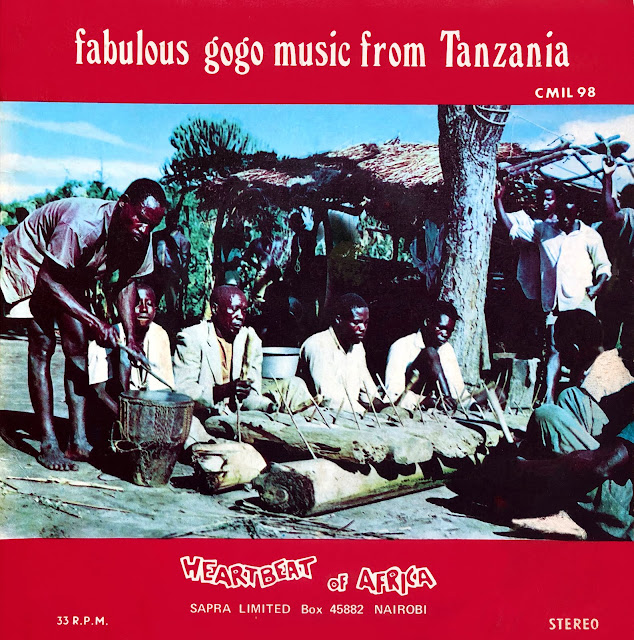Fabulous Gogo Music from Tanzania – Heartbeat of Africa – Sapra Ltd CMIL 98, recorded by David Fanshawe (7 in, 33 RPM)
The pastoral Gogo (aka Wagogo)
people inhabit the dry, semi-mountainous Dodoma region of central Tanzania. According
to Wagogo music specialist Polo Vallejo, “they are famous and admired for their
splendid vocal polyphonies. Their instrumental repertoires and dances illustrate
the originality, complexity and musical refinement of African music… One of the
most striking features of the Wagogo is that drums are played only by women.”*
David Fanshawe’s album
Fabulous Gogo Music from Tanzania is
an enthralling aural excursion with multilayered abstract complexity, fluid polyrhythms,
and telepathic collective performances: Funeral
Dance, to mourn the death of a leader with horns, flutes, percussion,
singing and choir (A1); Intoxicating
Marimba, with two marimbas whose sound box resonators are “covered by a
thin layer of spiderweb to create a vibrating buzz” (A2); Gogo Choirs, with rich vocal polyphony (A3); Kikombo Zeze, with two zeze
players (B1); Vipango Orchestra, with seven instruments and two
percussions (B2); and Songs of Cultivation, with singing,
horns, and percussion (B3).
These distinctive tracks, featuring
deep otherworldly sounds that extend beyond the confines of the instruments’ envelopes
through harmonics, vibration and distortion, exemplify how traditional African art
“is not a means but an end–transmutation from the human into the
supernatural.”**
Les Gogo (ou Wagogo) sont
un peuple pastoral de la région semi-montagneuse de Dodoma au centre de la
Tanzanie. Selon le spécialiste de la musique wagogo Polo Vallejo, « Ils
sont réputés et admirés pour leurs splendides polyphonies vocales. Leurs
répertoires instrumentaux et leurs danses particulières illustrent
l’originalité, la complexité et le raffinement musicaux du continent africain.
(…) Une des particularités les plus frappantes des Wagogo c’est que seules
les femmes battent le tambour. »*
L’album Fabulous Gogo Music from Tanzania enregistré par David
Fanshawe est un voyage captivant fait de musiques complexes et
abstraites, de polyrythmes fluides et de performances collectives
télépathiques: Dance funèbre pour pleurer la mort d’un dirigeant, avec trombes,
flûtes, percussions, chants et choeur (A1); Marimbas enivrantes, avec
deux marimbas dont les caisses de résonance sont « recouvertes d'une fine
couche de toile d'araignée pour obtenir un bourdonnement » (A2); Cœurs
Wagogo, avec une riche polyphonie vocale (A3); Kikombo Zeze, avec
deux joueurs de zeze (B1); Orchestre Vipango, avec sept instruments et
deux percussions (B2); et chants agricoles avec voix, trombes et percussions
(B3).
Ces morceaux, composés de sonorités profondes avec des harmoniques, des
vibrations et des distorsions qui font déborder les instruments de leurs enveloppes,
illustrent bien que l’art africain traditionnel « n’est pas un moyen mais
une fin – une transmutation de l’humain vers le surnaturel ».**
**Francis Bebey’s African
Music – A People’s Art, Laurence Hill Books, 1975.
Download
David Fanshawe (1942-2010) was an English composer whose most famous work was the album African Sanctus (1972), which combines Western choral harmony with his recordings of traditional African music. Fanshawe passionately explored the great diversity of our dying global traditional musical heritage and painstakingly recorded thousands of hours of indigenous music in Europe, Egypt, Sudan, Uganda, Kenya, Tanzania, Afghanistan, Iraq, Bahrain, and the Pacific islands.
Our other post of a David Fanshawe recording:
Kenya – Sounds of Masailand – Sapra Ltd here
Photograph below is from Les Civilisations Noires by Jacques Maquet, Marabout Université, 1962:
Wagogo boys during
a circumcision ceremony, photographed by George Rodgers (1908-1995), late 1940s.
Please help me purchase important traditional records to pursue my global curation project and share the best finds with you on this blog:





once again thank You for this wonderful share ... much appreciated!!!
ReplyDeleteSupernatural/Surnaturel!
ReplyDeleteGreat share - thank you very much!!!
ReplyDelete